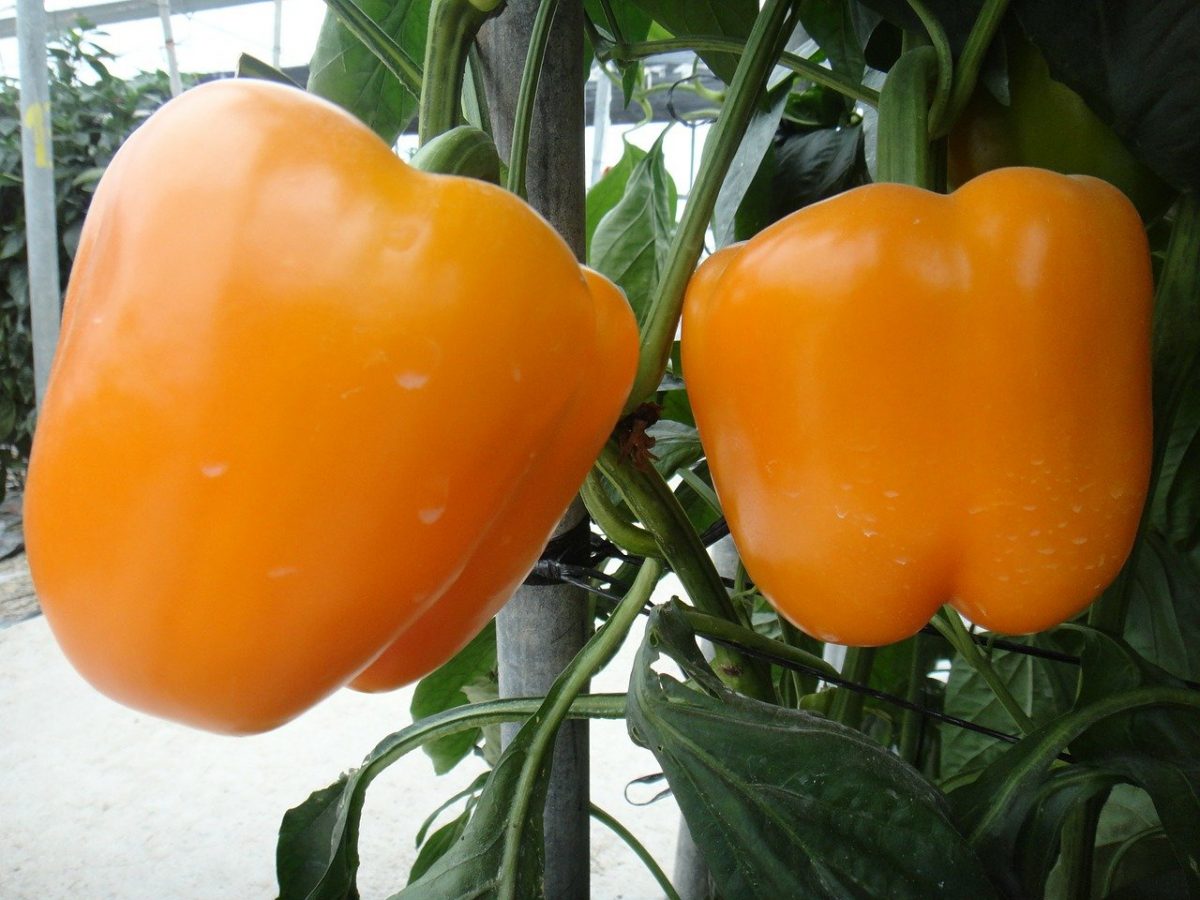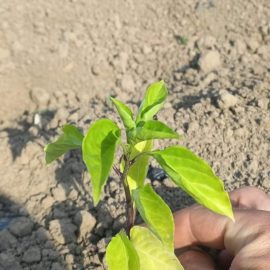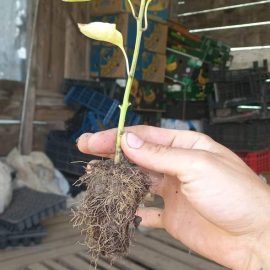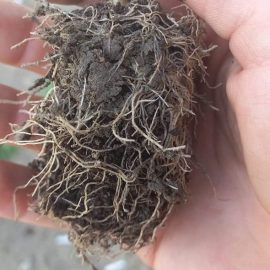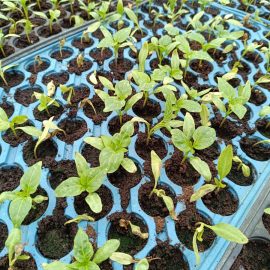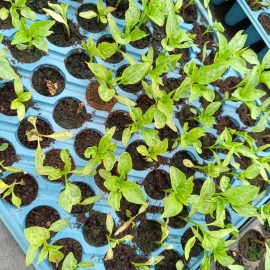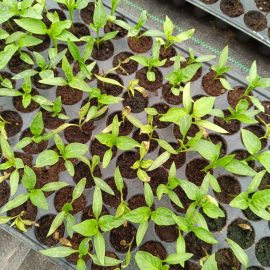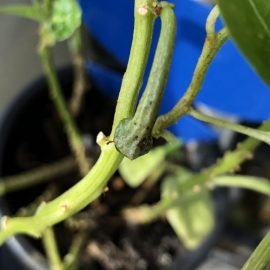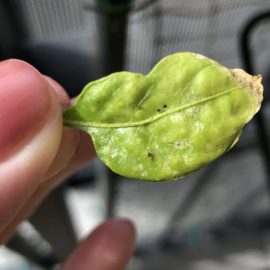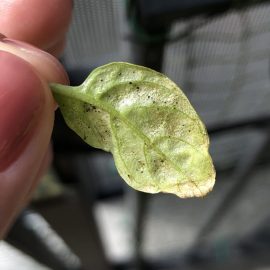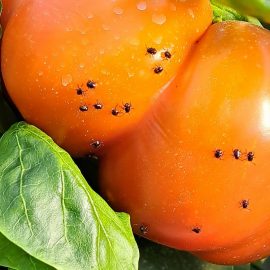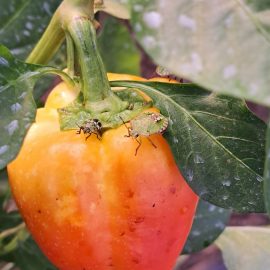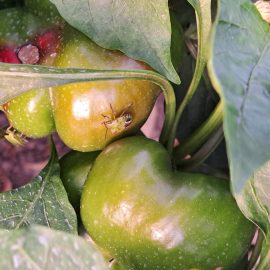Pepper, crop management
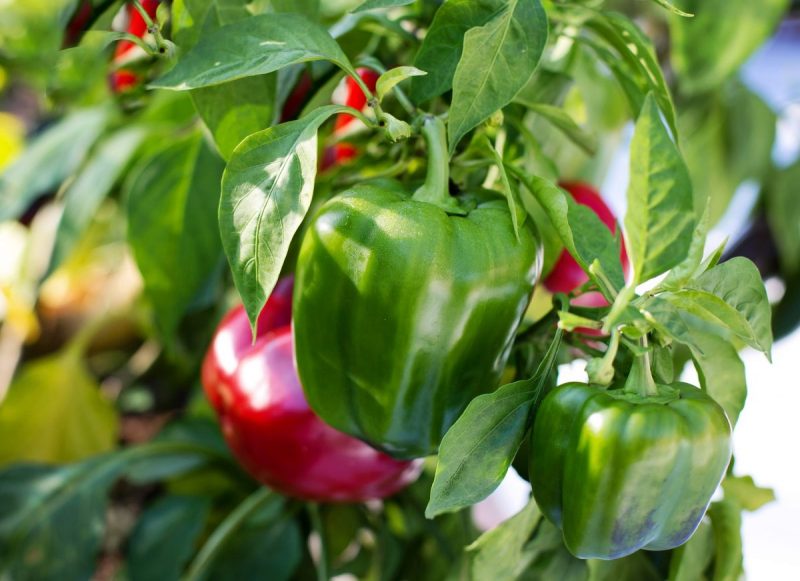
Pepper (Capsicum annuum) is a plant that occupies an important place among vegetable crops. The edible part of peppers is the fruit, which is used to prepare a wide range of dishes and canned foods. It can also be consumed fresh, in salads, as well as dried, in the form of paprika. Thanks to its capsaicin content, hot pepper can be used in the pharmaceutical industry.
The pepper is native to America, Mexico, Guatemala, and from here it has spread to the north, to the USA, and south, to Colombia, Venezuela, Ecuador, Brazil, etc. The pepper arrived in Europe in the 10th century.
The primary root is a taproot and has numerous secondary roots. The stem has fragile offshoots, with sympodial growth. The leaves are simple, and green, with a lanceolate-cordate shape. The flowers are type 5, hermaphroditic, solitary. A plant produces about a hundred flowers, but the majority of them perish. The fruit is a berry of various shapes, sizes, and colors, with seeds on the placenta. Fruits grow on the central stem first, then on lateral branches.
Climate and soil requirements
The total sum of temperature (℃) a pepper needs during the growing season is 3000℃. It grows harmoniously when temperatures are between 15 and 25℃. When temperatures drop below 15℃, the plant’s growth stagnates. Peppers have high light requirements, and the lack of light prolongs the growing season, reducing fructification. Light intensity has a particular effect on root development. Insufficient watering can cause a large number of blossoms to die off and the resulting fruit matures slowly and develops unusual shapes. The greatest harvest is obtained when the soil maintains a moisture content of 65% of the field’s water capacity. Peppers prefer light, sandy-loam alluvial soils with a slightly acidic pH.
Cultivation
PEPPER CULTURE IN THE FIELD
Crop rotation
Planting peppers after alfalfa, clover, peas, or beans provides the best results. It can also be planted after root and bulb vegetables, as well as pumpkins. Before planting peppers in the spring, lettuce, spinach, radishes, and green onions can be cultivated.
Soil preparation
In autumn, before plowing, basic fertilization should be carried out. The technique of deep plowing (28-30 cm) is a method for incorporating fertilizers into the soil. In springtime, properly balanced fertilizers and dolomite with higher nitrogen content can be used, but only after a pH test.
Recommended products
-
You can find products on a different store
Change Store -
You can find products on a different store
Change Store -
You can find products on a different store
Change Store -
You can find products on a different store
Change Store -
You can find products on a different store
Change Store -
You can find products on a different store
Change Store -
You can find products on a different store
Change Store -
You can find products on a different store
Change Store -
You can find products on a different store
Change Store -
You can find products on a different store
Change Store -
You can find products on a different store
Change Store -
You can find products on a different store
Change Store -
You can find products on a different store
Change Store -
You can find products on a different store
Change Store -
You can find products on a different store
Change Store -
You can find products on a different store
Change Store -
You can find products on a different store
Change Store -
You can find products on a different store
Change Store -
You can find products on a different store
Change Store -
You can find products on a different store
Change Store -
You can find products on a different store
Change Store -
You can find products on a different store
Change Store -
You can find products on a different store
Change Store -
You can find products on a different store
Change Store
Pre-emergent herbicides approved for pepper cultivation can also be applied.
Recommended products
-
You can find products on a different store
Change Store -
You can find products on a different store
Change Store -
You can find products on a different store
Change Store -
You can find products on a different store
Change Store -
You can find products on a different store
Change Store -
You can find products on a different store
Change Store -
You can find products on a different store
Change Store -
You can find products on a different store
Change Store -
You can find products on a different store
Change Store -
You can find products on a different store
Change Store -
You can find products on a different store
Change Store -
You can find products on a different store
Change Store -
You can find products on a different store
Change Store -
You can find products on a different store
Change Store -
You can find products on a different store
Change Store -
You can find products on a different store
Change Store -
You can find products on a different store
Change Store -
You can find products on a different store
Change Store -
You can find products on a different store
Change Store -
You can find products on a different store
Change Store -
You can find products on a different store
Change Store -
You can find products on a different store
Change Store -
You can find products on a different store
Change Store -
You can find products on a different store
Change Store
Preparing and planting
Peppers are typically grown as seedlings in greenhouses or plant nurseries. Special substrates are recommended, but a combination of soil, sand, and peat can also be used.
Sowing can be done from February to March, using certified or pre-treated seeds. To increase precocity, the seeds can be kept soaked in a solution containing particular stimulants.
Recommended products
-
You can find products on a different store
Change Store -
You can find products on a different store
Change Store -
You can find products on a different store
Change Store -
You can find products on a different store
Change Store -
You can find products on a different store
Change Store -
You can find products on a different store
Change Store -
You can find products on a different store
Change Store -
You can find products on a different store
Change Store -
You can find products on a different store
Change Store -
You can find products on a different store
Change Store -
You can find products on a different store
Change Store -
You can find products on a different store
Change Store -
You can find products on a different store
Change Store -
You can find products on a different store
Change Store -
You can find products on a different store
Change Store -
You can find products on a different store
Change Store -
You can find products on a different store
Change Store -
You can find products on a different store
Change Store -
You can find products on a different store
Change Store -
You can find products on a different store
Change Store -
You can find products on a different store
Change Store -
You can find products on a different store
Change Store -
You can find products on a different store
Change Store -
You can find products on a different store
Change Store
The seeds are sown in rows 5 cm apart and 1-2 cm between seeds in rows, 1-2 cm deep, on the germination bed.1 kg of seed is required for one hectare. After the seedlings have developed two true leaves, they are placed in 7 × 7 cm or 5 x 5 cm containers. Following this, a rooting stimulator can be applied to promote the growth of the root system. One week after pricking out, depending on the plant’s needs, foliar fertilization with specific fertilizers can be carried out to supply the plants with the elements necessary for growth.
Recommended products
-
You can find products on a different store
Change Store -
You can find products on a different store
Change Store -
You can find products on a different store
Change Store -
You can find products on a different store
Change Store -
You can find products on a different store
Change Store -
You can find products on a different store
Change Store -
You can find products on a different store
Change Store -
You can find products on a different store
Change Store -
You can find products on a different store
Change Store -
You can find products on a different store
Change Store -
You can find products on a different store
Change Store -
You can find products on a different store
Change Store -
You can find products on a different store
Change Store -
You can find products on a different store
Change Store -
You can find products on a different store
Change Store -
You can find products on a different store
Change Store -
You can find products on a different store
Change Store -
You can find products on a different store
Change Store -
You can find products on a different store
Change Store -
You can find products on a different store
Change Store -
You can find products on a different store
Change Store -
You can find products on a different store
Change Store -
You can find products on a different store
Change Store -
You can find products on a different store
Change Store
The seedlings should be 55-60 days old when planted. The seedlings should be properly watered one day before planting and hardened off for 2-3 weeks before planting. This technique involves opening the nursery/greenhouse windows in the morning and closing them in the evening. In the last week, the windows are left open at night for the plants to acclimate to the new environmental circumstances.
Planting
Planting is done when the soil temperature is at least 15 degrees Celsius. The time of planting does not have a definite date because it is influenced by meteorological circumstances.
The interval between rows is 70-80 cm, and the distance between plants in each row varies on pepper type. Therefore, the range is 15-20 cm for bell peppers, 20-25 cm for flat peppers, 15 cm for long peppers, and 10 cm for hot peppers.
Watering and fertilizers are applied after planting to improve root systems. A specific fertilizer can be added during the next watering to boost fertility and soil structure, as well as offer enhanced root absorption.
Recommended products
-
You can find products on a different store
Change Store -
You can find products on a different store
Change Store -
You can find products on a different store
Change Store -
You can find products on a different store
Change Store -
You can find products on a different store
Change Store -
You can find products on a different store
Change Store -
You can find products on a different store
Change Store -
You can find products on a different store
Change Store -
You can find products on a different store
Change Store -
You can find products on a different store
Change Store -
You can find products on a different store
Change Store -
You can find products on a different store
Change Store -
You can find products on a different store
Change Store -
You can find products on a different store
Change Store -
You can find products on a different store
Change Store -
You can find products on a different store
Change Store -
You can find products on a different store
Change Store -
You can find products on a different store
Change Store -
You can find products on a different store
Change Store -
You can find products on a different store
Change Store -
You can find products on a different store
Change Store -
You can find products on a different store
Change Store -
You can find products on a different store
Change Store -
You can find products on a different store
Change Store
Weed control
Weed control can be done manually or mechanically. Herbicides that have been approved for use may be utilized for chemical control.
Recommended products
-
You can find products on a different store
Change Store -
You can find products on a different store
Change Store -
You can find products on a different store
Change Store -
You can find products on a different store
Change Store -
You can find products on a different store
Change Store -
You can find products on a different store
Change Store -
You can find products on a different store
Change Store -
You can find products on a different store
Change Store -
You can find products on a different store
Change Store -
You can find products on a different store
Change Store -
You can find products on a different store
Change Store -
You can find products on a different store
Change Store -
You can find products on a different store
Change Store -
You can find products on a different store
Change Store -
You can find products on a different store
Change Store -
You can find products on a different store
Change Store -
You can find products on a different store
Change Store -
You can find products on a different store
Change Store -
You can find products on a different store
Change Store -
You can find products on a different store
Change Store -
You can find products on a different store
Change Store -
You can find products on a different store
Change Store -
You can find products on a different store
Change Store -
You can find products on a different store
Change Store
Pests and diseases
Use the recommended fungicides and insecticides to control this issue. It is recommended that products with different ways of action and active ingredients are alternated so that diseases and pests do not develop resistance to treatments.
Irrigation
Irrigation is required for high production because pepper uses a lot of water. The first wetting is done right after planting, followed by a few days of not watering to help the root system develop deeper.
After that, water every 7-10 days until fruit development, and then water regularly to ensure that the plants get enough water to thrive. Typically, the watering rate is 300 cubic meters per hectare.
Fertilization
For better roots, use phosphorus-rich or balanced fertilizers 1-2 weeks after planting. Foliar fertilizer products may be used depending on the requirements of the crop and environment.
Recommended products
-
You can find products on a different store
Change Store -
You can find products on a different store
Change Store -
You can find products on a different store
Change Store -
You can find products on a different store
Change Store -
You can find products on a different store
Change Store -
You can find products on a different store
Change Store -
You can find products on a different store
Change Store -
You can find products on a different store
Change Store -
You can find products on a different store
Change Store -
You can find products on a different store
Change Store -
You can find products on a different store
Change Store -
You can find products on a different store
Change Store -
You can find products on a different store
Change Store -
You can find products on a different store
Change Store -
You can find products on a different store
Change Store -
You can find products on a different store
Change Store -
You can find products on a different store
Change Store -
You can find products on a different store
Change Store -
You can find products on a different store
Change Store -
You can find products on a different store
Change Store -
You can find products on a different store
Change Store -
You can find products on a different store
Change Store -
You can find products on a different store
Change Store -
You can find products on a different store
Change Store
During the flowering and fruit binding period, fertilizers rich in calcium or boron can be applied for good fruit binding.
Recommended products
-
You can find products on a different store
Change Store -
You can find products on a different store
Change Store -
You can find products on a different store
Change Store -
You can find products on a different store
Change Store -
You can find products on a different store
Change Store -
You can find products on a different store
Change Store -
You can find products on a different store
Change Store -
You can find products on a different store
Change Store -
You can find products on a different store
Change Store -
You can find products on a different store
Change Store -
You can find products on a different store
Change Store -
You can find products on a different store
Change Store -
You can find products on a different store
Change Store -
You can find products on a different store
Change Store -
You can find products on a different store
Change Store -
You can find products on a different store
Change Store -
You can find products on a different store
Change Store -
You can find products on a different store
Change Store -
You can find products on a different store
Change Store -
You can find products on a different store
Change Store -
You can find products on a different store
Change Store -
You can find products on a different store
Change Store -
You can find products on a different store
Change Store -
You can find products on a different store
Change Store
The maturation of fruits requires more potassium, and in this situation, you can use products like:
Recommended products
-
You can find products on a different store
Change Store -
You can find products on a different store
Change Store -
You can find products on a different store
Change Store -
You can find products on a different store
Change Store -
You can find products on a different store
Change Store -
You can find products on a different store
Change Store -
You can find products on a different store
Change Store -
You can find products on a different store
Change Store -
You can find products on a different store
Change Store -
You can find products on a different store
Change Store -
You can find products on a different store
Change Store -
You can find products on a different store
Change Store -
You can find products on a different store
Change Store -
You can find products on a different store
Change Store -
You can find products on a different store
Change Store -
You can find products on a different store
Change Store -
You can find products on a different store
Change Store -
You can find products on a different store
Change Store -
You can find products on a different store
Change Store -
You can find products on a different store
Change Store -
You can find products on a different store
Change Store -
You can find products on a different store
Change Store -
You can find products on a different store
Change Store -
You can find products on a different store
Change Store
To help plants overcome periods of stress, foliar and root fertilization can be applied using stimulators.
Harvesting
It can begin as early as the first decade of July and last until the first frost. Bell, hot, and long peppers are harvested at commercial maturity, while flat and paprika peppers are harvested at physiological maturity. Manual harvesting is done by cutting the top of the stem.
PEPPER CULTURE IN POLYHOUSES
Soil
It occurs in the same manner as field cultivation, starting in the fall after the previous crop has been removed. Because the probability of diseases and pests is higher in protected areas, it is suggested that seedlings get disinfected with specific treatments before planting.
Planting
Planting in unheated polyhouses starts in the first decade of April, or earlier if heating systems are installed. Polyhouses covered with double-layer thermal foil are encouraged to be used. On the higher levels, four rows are planted 80 cm apart, with a 50 cm spacing between the plants. Pepper seeds are washed and disinfected to produce pepper seedlings.
Care
- Mulching can be done with straw, bark mulch, wood chips, or plastic wrap during or before planting.
- The temperature should be kept between 22°C during the day and 18°C at night.
- Watering is continued after planting when the soil moisture falls below 70%. Soil moisture is maintained at 70% till harvesting, and it must reach 80-90% during harvesting.
- Daily ventilation is done while ventilation windows are kept regularly open throughout the hot months.
- The first flowers develop 20-30 days after planting, and the first flower bud is cut to promote plant growth.
Plants cultivated in protected locations grow quickly and require more frequent and bigger amounts of water than plants growing in the field. Fertilizers can be applied using water-soluble fertilizers using a drip-irrigation method. According to agricultural crop suggestions, root fertilization is boosted with foliar fertilizer.
Harvesting
Depending on the crop cycle, the process occurs through multiple stages. Harvest time varies by both the date of planting and the technology used for plant growth and development.



















































































































































































































































































































































































































































